
# 3562 - 2002 34c Greetings From America: Alaska
Alaska
34¢ Greetings From America
City: New York, NY
Quantity: 200,000,000
Printed by: American Packaging Corp for Sennett Security Products
Printing Method: Photogravure
Perforations: Serpentine Die Cut 10.75
Quantity: 200,000,000
Alaska Becomes America’s 49th State
On January 3, 1959, Alaska joined the United States.
Most scientists believe the first people to live in America walked across a land bridge that connected Asia to Alaska more than 20,000 years ago. Then in 1648, Semen I. Dezhnev led a group of Russians across the narrow body of water that separates Asia from Alaska.
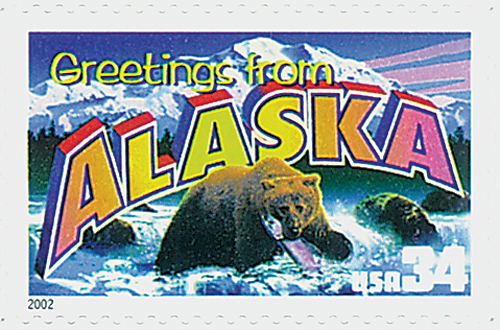
Over the years, fur brought Russian hunters and traders to Alaska. On the Aleutian Islands, and later on the mainland, a lucrative fur trade was developed. As a result, the populations of fur-bearing animals were decimated. The first white settlement in Alaska was established on Kodiak Island, in 1784. It was founded by Gregory Shelikof, who called it Russian America.
Russia attempted to build several industries in Alaska, including coal mining, ship building, and whaling. However, once the fur trade became less profitable, interest in the area declined. Russia’s economy was damaged by the costly Crimean War (1853-56). As a result, Russia decided to sell Alaska in 1867.
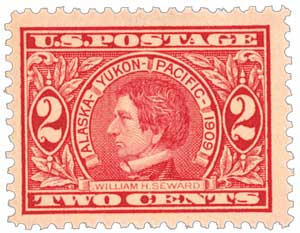
U.S. Secretary of State William H. Seward agreed to buy Alaska for $7,200,000 – a cost of about 2¢ per acre. Today, with the perspective of history, Seward’s purchase is seen as a stroke of genius. At the time, many Americans opposed the purchase. In fact, some called it “Seward’s Folly”, and referred to Alaska as “Seward’s Icebox” and “Icebergia.” However, not all Americans opposed the purchase, and Congress approved the treaty.
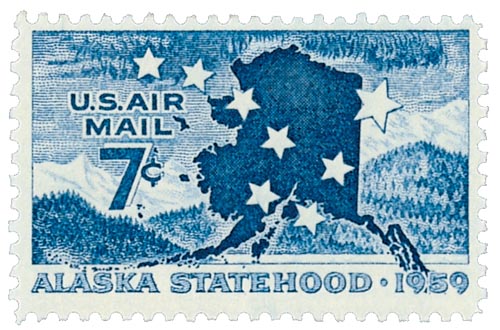
Alaska had no independent government for the next 17 years. The territory was administered by the War Department, then the Treasury Department, and finally the Navy Department. No attention was given to local matters. Salmon first attracted U.S. companies to Alaska. The first cannery was built in 1878. Congress passed the First Organic Act for Alaska in 1884, establishing Alaska as a distinct “civil and judicial district.” Alaska was provided with a governor, a code of laws, and a federal court. However, Alaska’s laws were identical to Oregon’s, and did not fit Alaska’s conditions. Congress remained in control of lawmaking for Alaska.
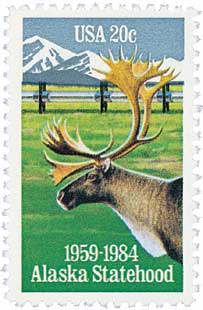
Joseph Juneau and Richard T. Harris discovered gold in southeastern Alaska in 1880. Additional gold strikes led thousands to flock to Alaska to prospect and mine for gold. Between 1890 and 1900, Alaska’s population almost doubled, reaching 63,952 people.
Gold brought government attention to Alaska. A Board of Road Commissioners was created to build roads, trails, bridges, and ferries throughout the populated areas of the territory. In 1906, Alaskans were allowed to elect a representative to Congress. This representative could speak before the Congress, but could not vote. In 1912, the second Organic Act provided Alaska with a territorial legislature, with limited power.
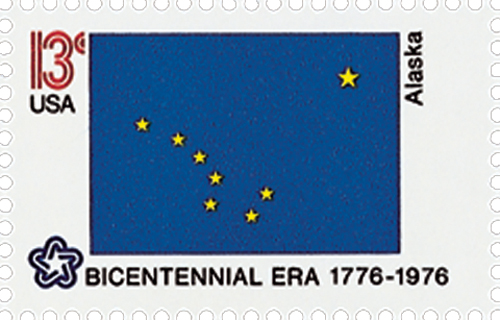
Japanese attacks on Alaska during World War II changed perceptions about the territory, and movements for statehood were initiated. Several bills were introduced between the mid-1940s and the late 1950s. In 1958, Congress finally voted to admit Alaska into the Union and on January 3 Alaska achieved statehood. It was the first new U.S. state since 1912.
Alaska
34¢ Greetings From America
City: New York, NY
Quantity: 200,000,000
Printed by: American Packaging Corp for Sennett Security Products
Printing Method: Photogravure
Perforations: Serpentine Die Cut 10.75
Quantity: 200,000,000
Alaska Becomes America’s 49th State
On January 3, 1959, Alaska joined the United States.
Most scientists believe the first people to live in America walked across a land bridge that connected Asia to Alaska more than 20,000 years ago. Then in 1648, Semen I. Dezhnev led a group of Russians across the narrow body of water that separates Asia from Alaska.

Over the years, fur brought Russian hunters and traders to Alaska. On the Aleutian Islands, and later on the mainland, a lucrative fur trade was developed. As a result, the populations of fur-bearing animals were decimated. The first white settlement in Alaska was established on Kodiak Island, in 1784. It was founded by Gregory Shelikof, who called it Russian America.
Russia attempted to build several industries in Alaska, including coal mining, ship building, and whaling. However, once the fur trade became less profitable, interest in the area declined. Russia’s economy was damaged by the costly Crimean War (1853-56). As a result, Russia decided to sell Alaska in 1867.

U.S. Secretary of State William H. Seward agreed to buy Alaska for $7,200,000 – a cost of about 2¢ per acre. Today, with the perspective of history, Seward’s purchase is seen as a stroke of genius. At the time, many Americans opposed the purchase. In fact, some called it “Seward’s Folly”, and referred to Alaska as “Seward’s Icebox” and “Icebergia.” However, not all Americans opposed the purchase, and Congress approved the treaty.

Alaska had no independent government for the next 17 years. The territory was administered by the War Department, then the Treasury Department, and finally the Navy Department. No attention was given to local matters. Salmon first attracted U.S. companies to Alaska. The first cannery was built in 1878. Congress passed the First Organic Act for Alaska in 1884, establishing Alaska as a distinct “civil and judicial district.” Alaska was provided with a governor, a code of laws, and a federal court. However, Alaska’s laws were identical to Oregon’s, and did not fit Alaska’s conditions. Congress remained in control of lawmaking for Alaska.

Joseph Juneau and Richard T. Harris discovered gold in southeastern Alaska in 1880. Additional gold strikes led thousands to flock to Alaska to prospect and mine for gold. Between 1890 and 1900, Alaska’s population almost doubled, reaching 63,952 people.
Gold brought government attention to Alaska. A Board of Road Commissioners was created to build roads, trails, bridges, and ferries throughout the populated areas of the territory. In 1906, Alaskans were allowed to elect a representative to Congress. This representative could speak before the Congress, but could not vote. In 1912, the second Organic Act provided Alaska with a territorial legislature, with limited power.

Japanese attacks on Alaska during World War II changed perceptions about the territory, and movements for statehood were initiated. Several bills were introduced between the mid-1940s and the late 1950s. In 1958, Congress finally voted to admit Alaska into the Union and on January 3 Alaska achieved statehood. It was the first new U.S. state since 1912.











